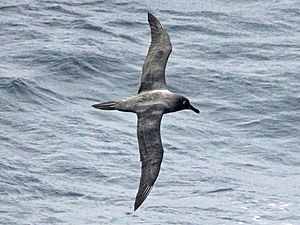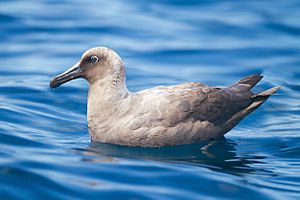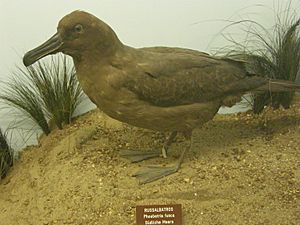Sooty albatross facts for kids
Quick facts for kids Sooty albatross |
|
|---|---|
 |
|
| Conservation status | |
| Scientific classification | |
| Genus: |
Phoebetria
|
| Species: |
fusca
|
The sooty albatross, dark-mantled sooty albatross or dark-mantled albatross, (Phoebetria fusca), is a species of bird in the albatross family. They breed on sub-Antarctic islands and range at sea across the Southern Ocean from South America to Australia.
Contents
Taxonomy
Sooty albatrosses are a type of albatross that belongs to family Diomedeidae of the order Procellariiformes, along with shearwaters, fulmars, storm petrels, and diving petrels. They share certain identifying features. First, they have nasal passages which attach to the upper bill called naricorns. Although the nostrils on the albatross are on the sides of the bill, the bills of Procellariiformes are also unique in that they are split into between 7 and 9 horny plates. Finally, they produce a stomach oil made up of wax esters and triglycerides which is stored in the proventriculus. This is used against predators as well as being an energy-rich food source for chicks and for the adults during their long flights. They also have a salt gland that is situated above the nasal passage and helps desalinate their bodies, which is necessitated by the high amount of sea water that they imbibe. It excretes a richly saline solution from the nose.
Description
The sooty albatross is a medium-sized albatross, measuring about 85 cm (33 in), with a 2 m (6.6 ft) wingspan. Adult body mass ranges from 2.1 to 3.4 kg (4.6 to 7.5 lb). It is sooty-brown with darker shading on the sides of its head. It has a white crescent above and behind its eye. Its bill is black with an orange or yellow sulcus. The tail of this albatross is wide diamond-shaped. Juveniles are similar to adults, although they can have paler feathers on the nape and upper back, possibly creating confusion with light-mantled albatross.
Behaviour
Feeding
Their diet consists of squid, crustaceans, cephalopods, fish, and carrion.
Reproduction
The sooty albatross is a colonial bird, although not to the same degree as other albatrosses, as their colonies usually consist of 50 to 60 pairs. They will build their nests on cliffs and steep slopes. Although are able to mate annually, they normally only do so biennially.
Range and habitat
This albatross nests on islands in the southern Atlantic Ocean (Gough Island and the Tristan da Cunha group) and Indian Ocean (Prince Edward Island, Marion Island, the Crozet Islands, Amsterdam Island, and Kerguelen Islands). They forage in both oceans north to about 30°S.
Conservation
The IUCN ranks the sooty albatross as endangered with an occurrence range of 40,800,000 km2 (15,800,000 sq mi) and a breeding range of 1,900 km2 (730 sq mi). A 1998 estimate placed the population at 42,000 adult birds.
Populations have shrunk 75% over the last 90 years, although the rate of reduction has recently slowed. The 21st century has so far seen stable populations at Gough Island.
This species is not excessively affected by longline fisheries, but instead by domestic cats eating eggs and chicks on Amsterdam Island and the Kerguelen Islands. Avian cholera, pasteurellosis, and erysipelas are major threats. Illegal poaching has nearly ceased.
Studies and surveys are conducted to assist in slowing its demise. It is a protected species on the Tristan da Cunha group, Gough Island is a World Heritage Site, and Prince Edward Island, Gough Island, and Inaccessible Island in the Tristan da Cunha group are protected nature preserves. Also, in 2007, the Crozet Islands, Amsterdam Island, and the Kerguelen Islands were declared nature preserves.
| Breeding Location | Breeding Pair | Trend |
| Gough Island | 5,000 | – 50% over 28 years |
| Tristan da Cunha | 4,125 to 5,250 | Unknown |
| Crozet Islands | 2,620 | −58% between 1980 and 1995 (Possession Island only) |
| Prince Edward Island and Marion Island | 1,720 | −25% between 1990 and 1998 (Marion Island only) |
| Kerguelen Islands | <5 | Unknown |
| Amsterdam Island | 300 to 400 | Unknown |
| Total | 12,500 to 19,000 | -75% over 90 years |
See also
 In Spanish: Albatros ahumado para niños
In Spanish: Albatros ahumado para niños




